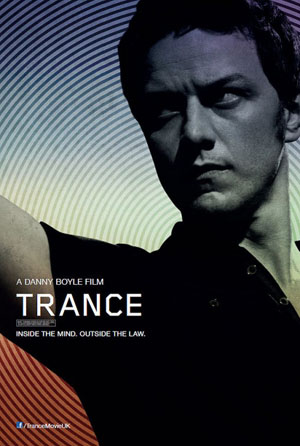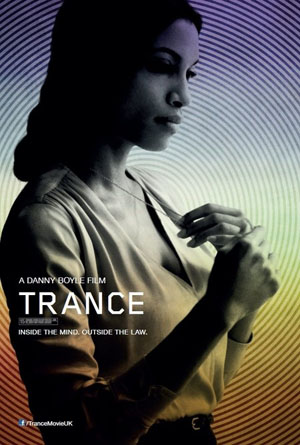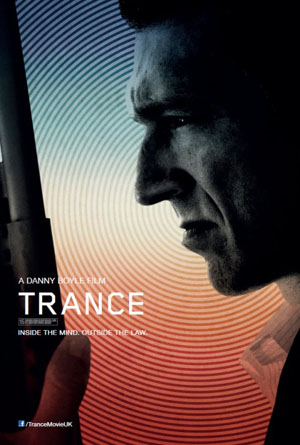By David Hudson
“What do you do for an encore once you’ve captured the nation’s heart and blown its mind with a stunning Olympic opening ceremony?” asks the Guardian‘s Peter Bradshaw. “How do you follow dropping the Queen from a helicopter? The answer, for that uniquely talented director Danny Boyle, is to change tack with a high-concept psychological heist thriller, headspinning in its ambition. It’s a film about the mind and its mysteries, with something of Christopher Nolan’s Inception and Memento and a little of the London gangland-locale of David Cronenberg‘s Eastern Promises. It’s a movie with a witty and intriguing starting point and I wanted to like it, this being virtually my patriotic duty. But Trance is a disappointment: a strident, chaotic, frantically overcooked film with an almost deafeningly intrusive ambient soundtrack.”
Variety‘s Peter Debruge does not disagree: “A trippy variation on the dream-within-a-dream movie, Boyle’s return-to-form crimer constantly challenges what auds think they know, but neglects to establish why they should care…. Boyle has cited Nicolas Roeg as an influence on the film’s disorienting style, and sure enough, Trance shares the jagged subjectivity of Performance and Don’t Look Now, along with the director’s raw treatment of anger and arousal…. Superficial pleasures aside, however, the convoluted script jumps and dodges so often, it soon loses the thread of its own story.”
But we can turn to Time Out London‘s Dave Calhoun for an outline at least. As he explained when he interviewed Boyle earlier this month, Trance is “a London-set psychological mind game of a movie that sees James McAvoy as a slick employee at a high-class auction house who’s dragged into a fast-moving conspiracy when he’s hit over the head during a robbery at work and loses his memory. The thieves—including a vicious Vincent Cassel—need him to remember where a painting is hidden—which in turn leads to hypnotherapy sessions with Rosario Dawson and plunges the film into a tricksy storytelling vortex…. When he talks about it, [Boyle] mentions films like Memento and Eternal Sunshine of the Spotless Mind—films unafraid to take a story somewhere a bit head-scratchy. It’s very much a Boyle film: choppy, fast, inventive, with pumping music and colorful performances. It’s also violent: there’s a scene where we see a bullet blowing apart someone’s head in slow motion and in close-up.”
Boyle’s films, wrote the Guardian‘s Jonathan Freedland a few days later in his profile, “might seem bleak—drug addicts on sink estates, impoverished and abused children in the slums of Mumbai, a mountain climber forced to sacrifice a limb—but Boyle’s films are never hopeless. Indeed, he jokes that he is making the same film over and over again, each one the story of one character’s triumph against ‘insurmountable odds.’ The twist in Trance—a psychological thriller full of twists—is that you don’t know until the very end who that person is.”
Updates, 3/21: The Hollywood Reporter‘s Todd McCarthy notes that the “knotty” screenplay’s been written “by Joe Ahearne (who wrote and directed the little-seen 2001 British TV movie of the same name) and John Hodge (who scripted Boyle’s first four films, beginning with Shallow Grave and Trainspotting)… Trance is not precisely a case of all style and no substance, as Boyle and his writers are, in fact, trying to deepen and, in certain ways, humanize hardboiled crime drama by introducing multiple layers of meaning, emotion and insight; enough pieces of the puzzle fit that the story, if one straightens the sequencing and psychology out in one’s mind, seems to make sense. All the same, the overriding impression is one of a game in which the narrative tricks and amped-up pulse dominate over all other concerns. It’s as if the challenge the filmmakers set for themselves was not so much to tell a story as to discover how many clever and devious ways they could disguise and hide what’s coming, to the point that the subject seems to serve the style rather than the other way around.”
The Playlist‘s Oliver Lyttelton argues that Trance is “a picture that, if it’s not quite Boyle’s very best, is probably his most satisfying and coherent since Trainspotting…. While Boyle assembled his old gang behind the camera, in front of it, they’re all new faces for the filmmaker, and all rise to the occasion. Cassel at first seems to have the least interesting part; the same kind of Euro-heavy he’s played countless times in the past. But as the film progresses, he’s allowed to get more vulnerable, and sexier, and is really flourishing by the end. Meanwhile, McAvoy might give his best performance to date here; cast somewhat against type, and very effectively so, he gets to make use of both his natural likability, and the certain malevolence that lurks in his grin. Best of all is Dawson, who’s never had a part of this quality, and tears into it like she’s been starving. Never quite edging into femme fatale, she turns on a dime, and ultimately proves to be the most immediately identifiable figure in the film once it plays all its cards. Plus, given that she’s one of our most pre-Raphaelite-evoking actresses, her casting turns out to be a coup on multiple levels. (There’s also some strong support from Danny Sapani, Matt Cross and Wahab Sheikh as Cassel’s crew, and Tuppence Middleton as a mysterious woman).”
Trance is “essentially Eternal Inception of the Spellbound Mind,” suggests Guy Lodge in Time Out London, “though its shallow mind games are strictly disconnected from the heart. Like a jigsaw puzzle of a priceless painting, the fun lies in putting it together, not contemplating the fractured final product. Still, after Slumdog Millionaire and the stifling 127 Hours, it’s a kick to see Boyle back in lickety-split genre mode… [T]his is the kind of film he might have made in the ’90s, only flashing all the technical elan he’s gained since then. Due respect to McAvoy, but it’s cinematographer Anthony Dod Mantle and his gorgeous, radioactive vision of our city that are the true stars here. It’s a different London celebration to the one Boyle directed last summer, but no less enticing.”
Update, 3/23: “Trance is stylish escapist fun that makes excellent use of reflective surfaces including the iPad, among other visual tricks—when it isn’t pummeling you into submission.” Anne Thompson introduces an interview with Boyle.
Update, 3/27: Boyle talks briefly with the Guardian, but he’s got a much longer conversation with Simon Mayo and Mark Kermode.
Updates, 3/30: “Danny Boyle’s films tend to land somewhere on a sliding scale between buoyancy tinged with menace and menace tinged with buoyancy,” writes R. Kurt Osenlund in Slant. “Trance, which features rough violence straight out of genre fare like 28 Days Later, and eventual uplift somewhat akin to that of Slumdog Millionaire, proves especially hard to place on the auteur’s tonal meter…. Here, you get that orange-heavy palette and those quasi-fish-eye views, but also hard-R elements largely unbuffered by any modern Boylean polish. You get trippy uncertainty as warped as the misadventures of the Trainspotting crew, but also that familiarly rhythmic, pulsating glee, which almost seems present just to keep your psyche safe. One of the finer examples of Boyle’s aptitude for melding grit and gleam, Trance contains within it so much of its uniquely fantastical director, and that’s just one reason why it’s such an entertaining sit.”
The Telegraph‘s Robbie Collin suggests that we “think The Lavender Hill Mob (1951) as directed by Christopher Nolan, but glossy with nudity and gore in a way that is unmistakably Boylean.” The Independent‘s Anthony Quinn finds that “for all the frantic energy on display, it’s a film that never really satisfies or convinces.”
In the New York Times, David Carr recalls talking with Boyle in Austin—onstage as a SXSW event, “and off, over a meal at the Four Seasons restaurant nearby.” Henry Banrnes interviews Dawson for the Guardian.
Update, 3/31: “Boyle’s directing often strikes me as the cinematic equivalent of 1980s pop production,” writes Jonathan Romney in the Independent: “you’d have liked the songs a lot better without all the reverbed drums, treated guitars and synthesizers stacked to the rafters.There’s cinematic mastery here, no doubt, but of a decidedly empty sort. The result isn’t so much trance as de luxe torpor.”
The Observer‘s Philip French suggests that “Boyle and Dod Mantle are influenced by another remarkable movie involving hypnosis and fleetingly recalled dreams: John Frankenheimer’s The Manchurian Candidate.”
Updates, 4/2: “Mind altering, trippy madness?” asks Kwenton Bellette at Twitch. “Check. Vincent Cassel in hardboiled mode? Check. A heist-based narrative? Check. But the plotting and pacing is so poorly strewn together that all these cool elements collapse in a messy psycho-sexual heap and the film becomes cluttered with sudden and overt twists that are poorly handled. The script is lousy, riddled with nonsensical, illogical and poorly planned out scenes, it has an immature temperament about it.”
And then there’s this:
THE ART OF THE HEIST (2013) from Tom Shone on Vimeo.
Updates, 4/6: “The payoff for solving puzzle films is a collaborative rush—in working out the filmmakers’ jigsaws, viewers are invited into the moviemaking process.” Zachary Wigon in the Voice: “Look at the uber-combative message boards about Primer, or brave the theorizing of Room 237,the docu-analysis of The Shining…. If rules-and-order-governed Inception is the intellectual law student at the party, and self-consciously fun The Adjustment Bureau is the pudgy dude who’ll dance with anybody, Trance is the really loud guy who won’t stop yelling about how 9/11 was an inside job: It’s got an awfully serious delivery, but the graver it gets, the sillier it becomes.”
“In this sexy, twisty neo-noir, time keeps folding back on itself in a origami sculpture that lures you into guessing whether the scene you’re watching is a memory, a fantasy or that Ponzi scheme known as reality,” writes Time‘s Richard Corliss. “A devious mind game, Trance is also the most entertaining smart movie so far this year.”
Tasha Robinson, who interviews Boyle for the AV Club, writes: “In Trance, viewers are expected to recognize a hypnotist as someone with a nigh-magical ability to manipulate subjective reality, and the entire story hinges on that unlikely belief.”
“Perhaps [Boyle] lifted this therapeutic idea from Spellbound, Hitchcock’s torturous 1945 thriller with Gregory Peck as an amnesiac whose traumatic memories are uncovered with the help of an analyst played by Ingrid Bergman,” suggests Manohla Dargis in the New York Times. “Hitchcock tapped Salvador Dalí to create the movie’s surrealistic dream sequences: soundstage hallucinations with enormous floating eyes and some perilously oversize scissors. Mr. Boyle’s inventions are more cinematically traditional and largely created with blunt-force editing, restless cameras and the bold turns mazing through Joe Ahearne and John Hodge’s script.”
Writing for Film Comment, Emma Myers finds that “beneath all of the high-concept razzle-dazzle is a narrative spine with a bad case of sclerosis.”
“First came Steven Soderbergh’s Side Effects, in which the retiring filmmaker brought his cool gaze and offhand naturalism to a story that was, he openly admitted, in the grand tradition of Fatal Attraction and Jagged Edge,” writes Jason Bailey at Flavorwire. “And now we have Trance… It’s trashy fun, to a point, but what’s most intriguing about stacking Boyle and Soderbergh’s films up against each other is how they succeed and fail in very nearly the same fashion: compelling setup, terrific vibe, lousy payoff.”
More from Nicholas Bell (Ioncinema, 2.5/5), Glenn Kenny (MSN Movies, 3/5), Joshua Rothkopf (Time Out New York, 2/5), and Mike Wilmington (Movie City News).
More chats with Boyle: Robert DeSalvo at Film.com and Jennifer Vineyard at Vulture, where she also talks with McAvoy.
Updates, 4/11: Trance is “is busy, bonkers, low down and a treat I was pleased to duck and swoon through on a dank gray Chicago spring afternoon,” writes Ray Pride at Newcity Film.
“Essentially a riff on the post-Memento puzzle, the film hums along, buoyed by Dawson’s sultry intelligence and Cassel’s sleazy charisma,” writes Sam Adams in the Philadelphia City Paper. “But eventually it runs out of switchbacks and double-bluffs, and calls in a third-act twist that’s both superfluous and offensive.”
Erik Henriksen in the Stranger: “When it comes to tapping into audiences’ nervous systems, Boyle’s disconcertingly good—which is probably why Trance, a movie about people hypnotizing people and people manipulating people, seemed like a great film for him to make. Boyle, after all, can be very good at these things—but Trance, alas, is not.”
Update, 4/13: “Trance is down and dirty and faintly ridiculous, and also pretty fun to watch,” finds Robert Horton.
Update, 4/16: For Ashley Clark, writing for Reverse Shot, “Trance’s most intriguing element is its… imagining of London as a Ballardian shadow space, with clichéd landmark locations carefully excised from the frame. Boyle has claimed, harking back to the voiceover at the beginning of Edinburgh-set Shallow Grave (‘This could be any city—they’re all the same’), that he wanted his London to be mythic and anonymous, and to a large extent he succeeds, boiling the landscape down to a handful of modish locations often attractively lit in blues, oranges, and reds.”
For news and tips throughout the day every day, follow @KeyframeDaily on Twitter and/or the RSS feed. Get Keyframe Daily in your inbox by signing in at fandor.com/daily.






